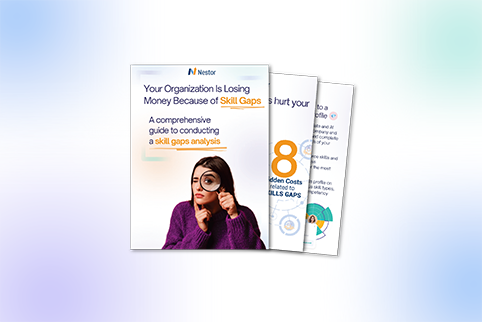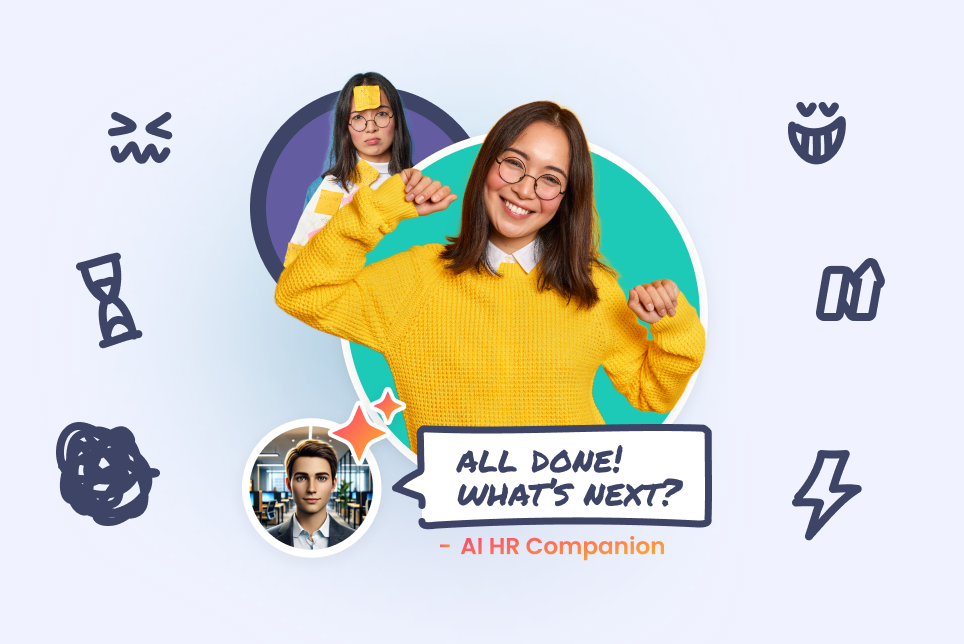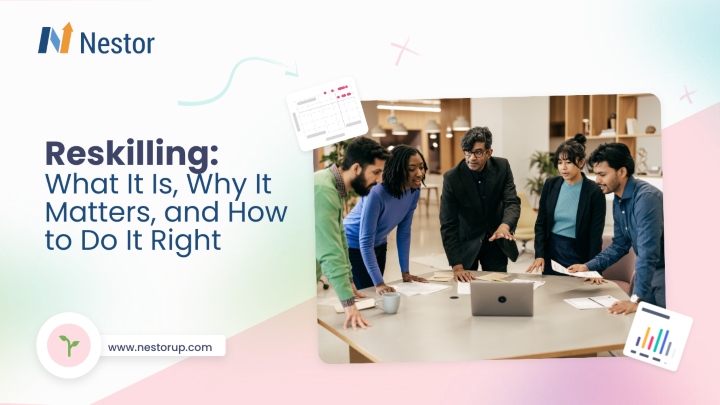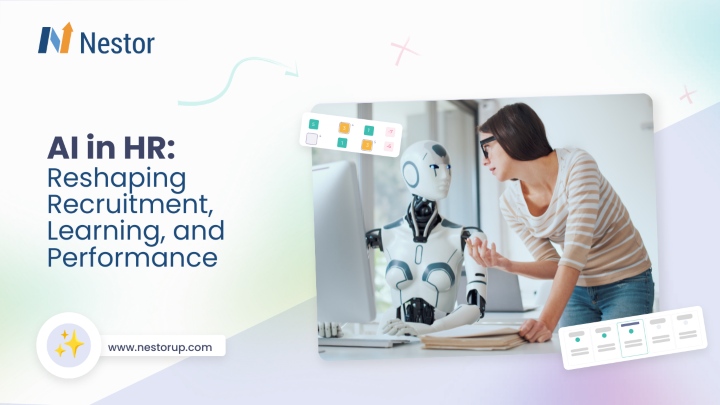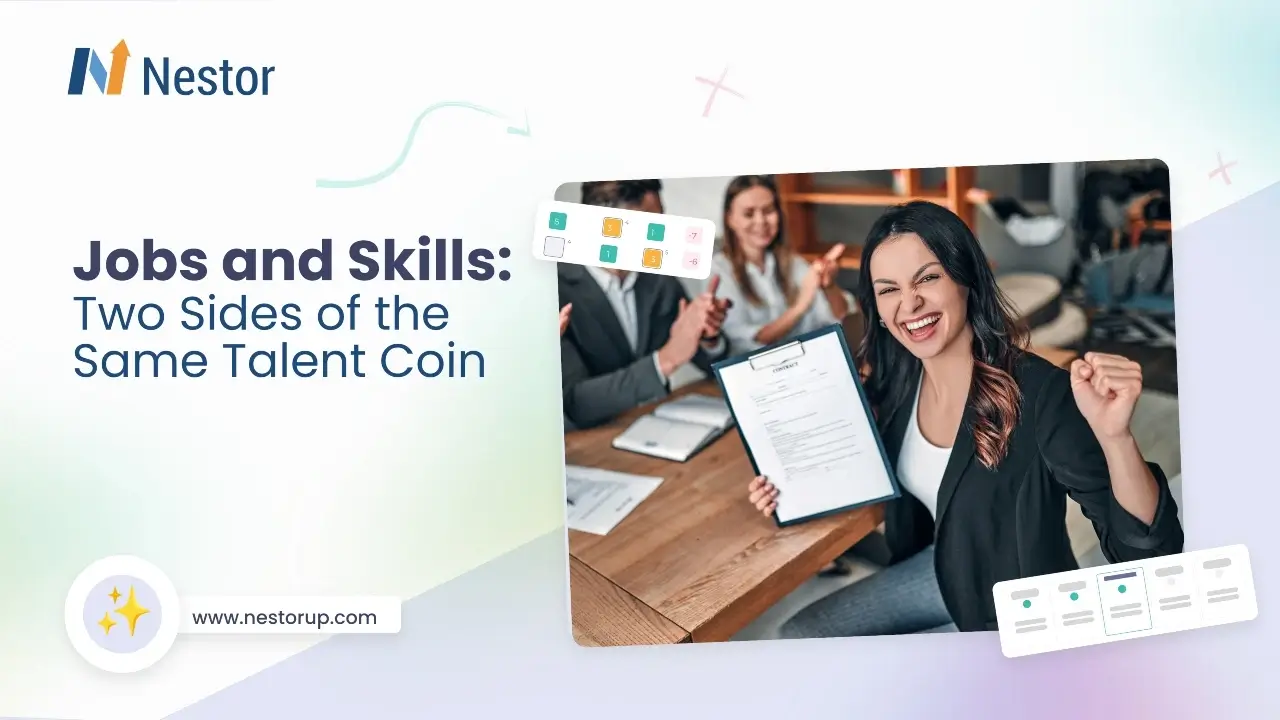
Contents
HR leaders talk a lot about jobs and skills. But somehow, the two still feel like separate conversations. Job titles define roles. Skills define people. That’s how most companies treat them. And that’s part of the problem.
First of all, you need to understand that jobs and skills are not in competition. They work together, or at least, they should. Job roles give people direction. Skills show how the work gets done. One doesn’t replace the other. You need both.
The problem is that too many businesses still cling to old models. Roles are static. Skills are vague. Employees get promoted based on assumptions, not capability. Managers don’t always know what to look for, and employees don’t always know what to improve.
Meanwhile, AI is changing work at a pace job titles can’t keep up with. A role that made perfect sense five years ago might now need completely different tools, systems, or problem-solving skills. And if you’re relying only on job descriptions to guide workforce planning, you’re falling behind.
A skills-based approach solves that.
It helps organizations see their people more clearly; not just by what role they were hired into, but by what they’re capable of today, and what they’re ready to learn next.
This shift doesn’t mean rewriting every job. It means giving roles more depth. It means showing people how they can grow within their role, instead of pushing them toward something else entirely.
Done right, this change doesn’t confuse people. On the contrary, it gives them more clarity. It doesn’t slow teams down, it makes them more flexible.
So why are we still asking whether we should focus on jobs or skills?
In this article, we’ll unpack the real relationship between jobs and skills, clear up the common myths, and show how HR teams can use skill data (with help from AI) to grow talent faster and smarter, without turning everything upside down.
6 Common Myths About Jobs and Skills (and Why They’re Wrong)
It’s easy to fall into outdated thinking when it comes to jobs and skills. Many HR teams still treat them like separate systems, but that mindset slows down workforce growth. To move forward, we first need to let go of the most common myths; the ones that block real transformation.
Here’s what’s holding most companies back:
Myth 1: “Skills Replace Jobs”
This is one of the most common misconceptions in conversations about the future of work. The assumption? That focusing on skills will somehow make job roles obsolete.
Reality: Skills don’t replace jobs, they reshape them.
Every job still has a purpose. But how we perform that job changes over time. New tools come in, processes evolve, and expectations shift. Skills help roles adapt to those changes. They keep jobs relevant.
Think of it this way: A job title is static. A skill set moves. By focusing on skill development, you’re not discarding roles, you’re upgrading them. That’s how upskilling employees effectively becomes a retention strategy, not just a training checkbox.
Myth 2: “If We Focus on Skills, We’ll Confuse People About Their Jobs”
Some leaders worry that talking too much about skills will muddy the waters. They fear employees will lose track of their responsibilities.
Reality: Skills bring more clarity, not less.
When you break a role down into key skill areas, you give employees a roadmap. They don’t just know what their job is; they understand how to get better at it. This creates a more confident, capable workforce that isn’t guessing what success looks like.
Skills also help teams speak the same language. “Strong communication” or “leadership potential” becomes measurable, not vague. And that matters for performance reviews, internal mobility, and fair promotions.
Myth 3: “You Either Have a Job Title or You Have Skills, Not Both”
Too often, companies treat roles and skills like separate boxes. Either someone is “a recruiter” or they “have people skills.” Either they’re “a data analyst” or they “know Python.”
Reality: A job is built from skills.
Every role is a bundle of tasks, and every task requires a set of capabilities. That’s what skills are. When HR ignores that connection, job roles become vague and unhelpful. You can’t train people effectively or build career paths if you don’t know which skills sit inside the job.
This is why more HR leaders are turning to skills-based HR strategies. They connect job roles with skills clearly and consistently, across the org chart.
Myth 4: “Skills Are Binary. You Either Have Them or You Don’t”
If your performance process is based on “has skill” vs. “doesn’t have skill,” you’re missing the full picture.
Reality: Skills have depth.
Proficiency matters. Someone might be learning a new tool but not confident using it in high-stakes situations. Another person might teach others that same tool. Those are two very different skill levels, and HR needs to account for both.
Modern platforms and tools (like Nestor) let you track skills across levels, not just checkboxes. That’s critical for development plans, internal mobility, and even fair compensation.
Myth 5: “Only Managers Need to See Skill Data”
This idea is rooted in old management styles; the belief that only leaders should track growth or access insights.
Reality: Everyone needs visibility to grow.
When employees can see their own skills, they engage more. They know what to work on. They recognize progress. And they take ownership of their development.
Think of it as the shift from performance reviews done to employees vs. done with employees. Skill transparency supports coaching, self-assessment, and better learning choices.
Your platform shouldn’t lock skill data behind the manager’s dashboard. It should bring those insights to everyone.
Myth 6: “AI Will Eliminate the Need for Skills”
There’s a lot of panic around AI and automation. Will machines take over? Will skills still matter?
Reality: AI changes which skills matter. It doesn’t eliminate the need for human ones.
Yes, AI can write copy, process data, and automate simple tasks. But it also creates demand for new skill sets:
- Critical thinking
- Adaptability
- Tech fluency
- Ethical reasoning
- Collaboration with intelligent systems
This is one of the most important conversations in HR digital transformation. AI doesn’t remove jobs, it changes them. The real challenge is making sure your workforce can adapt with the right upskilling.
Jobs and Skills Go Hand in Hand
For years, HR teams have treated jobs and skills like separate tools in the same toolbox. But they’re more like two parts of the same engine: one powers the direction, the other powers the motion. You need both working together to get anywhere.
Here’s a simple way to look at it:
- A job is a structured set of tasks and expected outcomes.
- Skills are the capabilities people bring to perform those tasks effectively.
When you strip away the formalities of a job description, what you’re left with is a pattern of skill clusters. Each role is a mix of technical, cognitive, and interpersonal abilities that adapt over time. That’s the real engine of performance.
Job titles can’t keep up with how fast work changes. Skills can. And when HR shifts the focus to skills, it creates a more fluid way to understand talent, design roles, and plan for the future.
Here’s how that shift looks in practice.
Role: HR Business Partner
Traditional description: “Advise managers on HR policies and employee relations.”
Skills-based view:
- Talent and workforce analytics
- Organizational design
- Coaching and stakeholder management
- Inclusion and equity strategy
- HRIS and talent platform fluency
- Navigating change and transformation
Modern HR isn’t just operational support. It’s strategic partnership. HRBPs now need to work with data, contribute to long-term workforce planning, and act as change agents across the business. The shift to skills helps highlight where HR can lead – not just support – organizational growth.
Role: Customer Support Agent
Traditional description: “Handle client complaints and troubleshoot issues.”
Skills-based view:
- Written and verbal communication
- Empathy and emotional regulation
- CRM and ticketing platform usage
- Conflict de-escalation
- Knowledge base editing and tagging
- Collaboration with AI chatbots and support automations
Support roles used to be reactive. Now they’re part of a connected service ecosystem. Agents need to switch between human empathy and digital tools seamlessly. The better they are at using systems and managing customer emotion, the more value they create.
Role: Marketing Manager
Traditional description: “Manage marketing campaigns and brand initiatives.”
Skills-based view:
- Customer journey mapping
- Campaign strategy and performance analysis
- Copywriting and creative briefing
- Search engine marketing (SEM), SEO
- CRM and automation tools (e.g. HubSpot, Marketo)
- Budget planning and cross-functional collaboration
Marketing is no longer just about branding. It’s about precision, agility, and experimentation. A title alone won’t tell you if someone knows how to A/B test an ad or optimize a funnel. But their skills will. This clarity helps HR match the right people to the right work at the right time.
Role: Financial Analyst
Traditional description: “Review financial data and prepare reports.”
Skills-based view:
- Financial modeling and forecasting
- Excel, Power BI, or Tableau proficiency
- Market trend analysis
- Data storytelling and executive reporting
- Risk modeling
- Scenario planning
Finance roles today aren’t just about interpreting numbers. They’re about creating insight that drives business action. The more transparent the skill data, the easier it becomes to move analysts into more strategic roles as their capabilities grow.
Why More Companies Are Making Skills Part of the Job Conversation
If skills and jobs go hand in hand, why are so many companies only now starting to treat them that way?
The answer is actually very simple: the nature of work has changed, and it keeps changing. Fast.
Technology isn’t just automating tasks. It’s reshaping the content of entire roles. AI, automation, and digital tools don’t always replace jobs. More often, they recompose them. A task that once defined a job might now take a few clicks. Meanwhile, brand-new responsibilities appear, and they need skills no one was hiring for five years ago.
That’s why the half-life of skills keeps shrinking. By 2028, 44 percent of worker skills will be disrupted. Research suggests the half-life of professional skills has dropped from 10 years to five, and the half-life for many technical skills is now below 2.5 years. Over a billion people will need to be reskilled by 2030, prompting the World Economic Forum to declare a “reskilling emergency.”
What once counted as advanced knowledge becomes the baseline. The only way to keep up is to build systems that adapt as quickly as the work does. That’s where skills come in.
Virtually all CEOs (90 percent) believe their company is facing disruptive change driven by digital technologies, and 70 percent say their organization does not have the skills to adapt. This doubt reflects the fact that skills are becoming obsolete at an accelerating rate. Software engineers must now redevelop skills every 12–18 months. Professionals in marketing, sales, manufacturing, law, accounting, and finance report similar demands.
— Deloitte
Skills give companies a dynamic way to track, map, and respond to change faster than any org chart can. Instead of waiting for new job descriptions to be written, teams can respond in real time by looking at the capabilities already in the workforce.
This isn’t just a theory. It’s already happening.
Some of the world’s largest employers – like LinkedIn, IBM, and Unilever – have shifted to skills-first strategies. They’re not tearing up their job structures. They are only adding depth. How? By using skill data to understand how people move, how work is changing, and where the biggest growth opportunities lie.
Here’s how they’re doing it:
- AI maps skills to roles: It shows which skills overlap, which ones are adjacent, and which ones are trending. This gives HR teams a clearer view of talent mobility.
- Skill assessments become automated: Instead of relying on manager gut feel, organizations can use tools that track learning progress, real performance, and readiness to grow.
- Capabilities become visible: Employees aren’t boxed in by their job title. Their skills show potential across functions, not just within one team.
And it pays off.
A skills-focused strategy helps you identify who’s ready for the next challenge, not just who’s been in their seat the longest. It connects learning with actual business goals. It shows where to invest in development, and where to reallocate talent.
More importantly, it helps companies avoid costly hiring cycles. If you can grow someone into a role in six months instead of searching for six months, you’ve already won. Internal mobility improves. Retention improves. People feel seen not just for what they were hired to do, but for what they can grow into.
How Skills Can Be Added to Any Job
One of the biggest myths in workforce development is that upskilling has to be disruptive. Many HR teams still treat it like a full system overhaul: new titles, new teams, new org charts. That’s exactly why it fails.
Most people don’t need a new job. They just need a better way to grow within the one they already have.
That’s where skill layering comes in.
Skill layering means building new capabilities on top of a person’s existing role. No dramatic pivots. No pressure to “reinvent” themselves. Just targeted, contextual development that fits how they already work.
It’s not about asking someone to become something else. It’s about helping them do more with the role they already own, and helping the business get more value from that growth.
Example: Office Manager
Baseline skills: Organization, communication, budgeting, scheduling
Skill layering:
- Add light data analysis (e.g., tracking space usage or vendor performance)
- Introduce tools like Asana, Notion, or Power BI
- Develop presentation skills to report on cost savings or efficiency
The title doesn’t need to change. But the impact does. These layers unlock new contributions, often without needing additional headcount.
Example: Sales Representative
Baseline skills: Product knowledge, relationship building, CRM fluency
Skill layering:
- Add customer insights analysis (e.g., identifying patterns in lost deals)
- Improve storytelling with data in pitches
- Learn adjacent skills like negotiation or pricing strategy
They’re still selling. But now they’re not just closing deals, they’re shaping strategy.
Skill Layering Creates Growth Without Disruption
This kind of growth is easier to manage, and easier to measure. Nestor supports this model by helping HR teams and employees work from the same map:
- Personalized skill maps show the specific skills tied to each role
- Progression paths outline what it looks like to grow without having to change titles
- AI-driven nudges suggest timely, relevant skill goals based on actual work
For HR, it’s a clear line of sight. You can see which roles are growing, where support is needed, and which employees are ready for more. For employees, it’s transparent; they know what’s expected and how to get there.
And you don’t need to start with a full list of every skill in the company. You start with a few that matter most in each role; the ones that show up in real work, in real conversations, and in performance reviews. Then you build from there.
How Nestor Bridges the Gap Between Jobs and Skills
A lot of HR platforms promise to help you manage skills. But most of them still keep those insights locked away, built for reporting, not action. The data sits with HR, disconnected from daily work, and too slow to guide real decisions.
That’s where Nestor is different.
Nestor brings real-time skill insights directly to the people who need them – employees, managers, and HR – in a way that’s simple, visible, and actionable.
Employees don’t have to guess what to work on next. They can see where they are, where they could grow, and what steps to take, all within the context of their current role. This clarity turns abstract goals into a visible path.
Managers stop relying on assumptions or outdated job descriptions. They can coach based on actual skill progress, backed by self-assessments, peer feedback, and performance data. That makes conversations more productive, and development more meaningful.
HR teams get a live view of workforce capabilities. Instead of planning based on titles and tenure, they can build strategies around what people can do, and what they’re ready to learn next. That makes internal mobility faster, smarter, and far more cost-effective than external hiring.
Why It Works
At its core, Nestor was designed to support modern, skill-based HR strategies, without forcing you to throw out your existing structure. Here’s how it makes that happen:
- AI-powered skills library with over 20,000 skills across 15 industries, ready to adapt to your roles
- Dynamic skill assessments that combine employee input, peer feedback, and manager reviews
- Gap analysis and learning paths that show where to grow and how to get there
- Internal mobility tools that match people to new roles or projects based on skills, not just resumes
- Leadership development and succession planning, backed by real-time growth tracking
- Performance management integration, so skills and impact stay linked
All of this is layered into a clean, user-friendly platform: no complicated setup, no friction for the end user. That’s one reason why companies in finance, healthcare, media, and IT trust Nestor to support large-scale transformation. And it’s why adoption rates are so high.
The Results
With Nestor, HR gains visibility and control. Employees gain direction and ownership. Managers gain the tools to lead more effectively. And the business gains momentum by making the most of the talent it already has.
- Engagement improves because people see their growth.
- Upskilling becomes personalized, not generic.
- Hiring costs drop because internal mobility increases.
- Retention goes up because development becomes transparent.
You don’t need a full rebuild to shift to a skills-first model. You need better visibility, smarter tools, and a platform that connects all the right people to the right information.
That’s what Nestor delivers.
How AI Makes Skills-Based Work Practical at Scale
Skills-based strategies make perfect sense on paper, but for many HR teams, the reality is messier. Trying to track every skill across every team manually? It’s not just time-consuming. It’s impossible. Especially when the work itself keeps shifting. That’s why artificial intelligence is no longer a nice-to-have. It’s what makes this approach doable.
In fact, the pressure to reskill is already here. Executives in a recent IBM survey said that 40% of their workforce will need to learn new skills within the next three years because of AI and automation. “That translates to 1.4 billion of the 3.4 billion people in the global workforce, according to World Bank statistics,” the study’s authors add.
But let’s be clear about one thing. AI isn’t just a reporting engine. It’s a system that recognizes patterns humans can’t spot fast enough.
For example:
- AI can analyze someone’s work history and suggest likely skills they already have, even if they haven’t been formally assessed. That makes it easier to get a baseline for every employee, not just those in high-visibility roles.
- It can identify adjacent skills (the capabilities just outside someone’s current role) and show what they’re close to learning next. This helps employees see logical, motivating growth paths that don’t feel like a leap.
- AI can also flag skills that need updating, not just when they’re missing, but when they’re becoming outdated based on how a role is evolving. That’s not something most HRIS systems can do on their own.
At a company level, this changes how organizations respond to shifts in the market. Instead of launching new hiring waves every time strategy shifts, teams can identify which employees are already 70% ready for the next challenge and build from there.
AI also streamlines how growth happens. Rather than assigning generic learning modules across departments, systems like Nestor personalize learning recommendations based on the skills that matter most in a specific context. That keeps development relevant, and avoids the fatigue of one-size-fits-all programs.
The real difference AI brings? It reduces delay. Whether you’re tracking capability at scale or nudging someone toward their next goal, you’re no longer reacting late. You’re steering early.
That’s the difference between knowing where you stand and being ready for what comes next.
A Practical Guide for HR Teams: Implementing a Skills-First Approach
You don’t need a transformation program to adopt a skills-first approach. You need structure, consistency, and a realistic way to start.
This isn’t about launching new frameworks overnight. It’s about giving people better visibility into how work gets done, and making smarter decisions about growth and development.
Here’s how HR teams can begin building a skills-based model that actually works.
Step 1: Identify Skill Signals Within Roles
Don’t start by rewriting job descriptions. Start by observing.
Look at 5–10 critical roles in your organization. Focus on what people actually do in those jobs, not what the original description says. What skills are behind their best work? Which ones are showing up in team performance? What do high performers do differently?
From there, extract 4–6 capabilities that are essential to that role’s success. These are your foundational skills.
Step 2: Create Role-Based Skill Profiles
Once you know which skills matter, define what they look like at different levels; from entry to expert. Keep it simple. Use practical language that managers and employees can relate to.
Example:
Skill: Stakeholder Communication
- Beginner: Can present updates clearly to internal teammates
- Intermediate: Can adjust message for different audiences across functions
- Advanced: Can lead communication with execs, clients, or external partners
These profiles form the blueprint for development, feedback, and learning without needing to change job titles.
Step 3: Make Skills Visible and Actionable
Visibility changes behavior. When employees can see their own skill profile, they start connecting their work with their growth. It’s no longer abstract. It becomes part of their day-to-day decisions.
Make sure these profiles live somewhere employees can access regularly, whether it’s inside your talent platform, performance review system, or learning portal. The more visible the skills, the more likely people are to engage with them.
Step 4: Use AI to Guide and Recommend
AI makes scaling this approach possible. Instead of expecting managers to build growth plans from scratch, AI can:
- Recommend learning based on skill gaps
- Suggest relevant internal roles or projects
- Highlight employees ready for new responsibilities
Don’t be afraid to use AI. It doesn’t replace human judgment. It just sharpens it. Managers and HR get prompts instead of dashboards, and employees get personalized next steps instead of vague goals.
Step 5: Track Outcomes That Matter
Finally, build a feedback loop. Look at metrics that signal progress, not just activity:
- Are employees moving into new roles internally?
- Do managers involve themselves in more development-focused conversations?
- Are promotion decisions more skill-informed than before?
- Is engagement improving among people in growth pathways?
Pick 3–5 indicators tied to real business outcomes. This gives you proof of progress, and the insight to improve as you go.
Start Small, Stay Consistent
You don’t have to change everything to make this work. Start with one department. One team. One high-impact role. Get the motion right. Build your confidence and your case for scale.
This isn’t about adding complexity to HR. It’s about removing the noise that slows people down and replacing it with a system that helps them grow.
Final Thoughts on Jobs and Skills
The way we define work is shifting. Job titles still matter because they give structure and accountability. But on their own, they’re no longer enough.
Skills are what bring job roles to life. They give teams the flexibility to grow and the relevance to stay effective as work evolves. When you understand what people can do and not just what they were hired to do, you unlock faster learning, better decisions, and stronger teams.
This isn’t about throwing out everything you know. It’s about moving beyond static titles and toward building skills-forward ecosystems where growth is continuous, roles are adaptable, and potential is easier to spot.
You don’t have to make the leap alone. Nestor gives you the tools to connect skills, performance, and development; all in one place. If you’re ready to rethink how your organization hires, grows, and plans for the future, book a demo today.
Frequently Asked Questions (FAQs) About Jobs and Skills
What is the difference between jobs and skills?
Jobs are defined by tasks and outcomes tied to a specific role. Skills are the capabilities people use to perform those tasks effectively. A single job may require many skills, and those skills can evolve faster than the job title itself.
Do skills replace jobs?
No, skills don’t replace jobs, they support them. Job roles provide structure, while skills bring flexibility. A role stays relevant over time because the skills behind it continue to grow. The goal isn’t to eliminate roles, but to make them more adaptive and future-ready.
Why focus on skills if we already have job descriptions?
Because job descriptions quickly become outdated. Skills offer a real-time view of capability. They make it easier to update roles without rewriting everything. Skills also help HR and managers see where people can grow beyond what their title suggests.
Can you build a workforce strategy around skills without removing jobs?
Yes. In fact, the most successful strategies do exactly that. You don’t need to get rid of jobs. You just need to layer in skill visibility. This helps employees grow within their roles, and gives organizations more agility without disruption.
Why are skills important in workforce planning?
Skills give HR teams a dynamic view of talent. Instead of relying on static titles or resumes, skills data shows what people are capable of today, and where they can grow next. This leads to better hiring, internal mobility, and development decisions.
What is a skills-based approach to HR?
A skills-based HR strategy focuses on identifying, developing, and applying employee capabilities across roles and teams. It helps organizations stay agile by aligning work with real-time skill sets, not just organizational charts.
How does AI help with managing skills?
AI supports skills management by mapping existing capabilities, identifying gaps, suggesting adjacent skills, and matching employees to learning or internal opportunities. It automates the hard part of keeping skills data current and useful.
How does Nestor support skills-based talent management?
Nestor provides AI-powered tools that map skills, personalize learning, and connect performance to real capability. It helps HR teams build skills-forward ecosystems by offering visibility, growth pathways, and actionable insights across the employee lifecycle.



